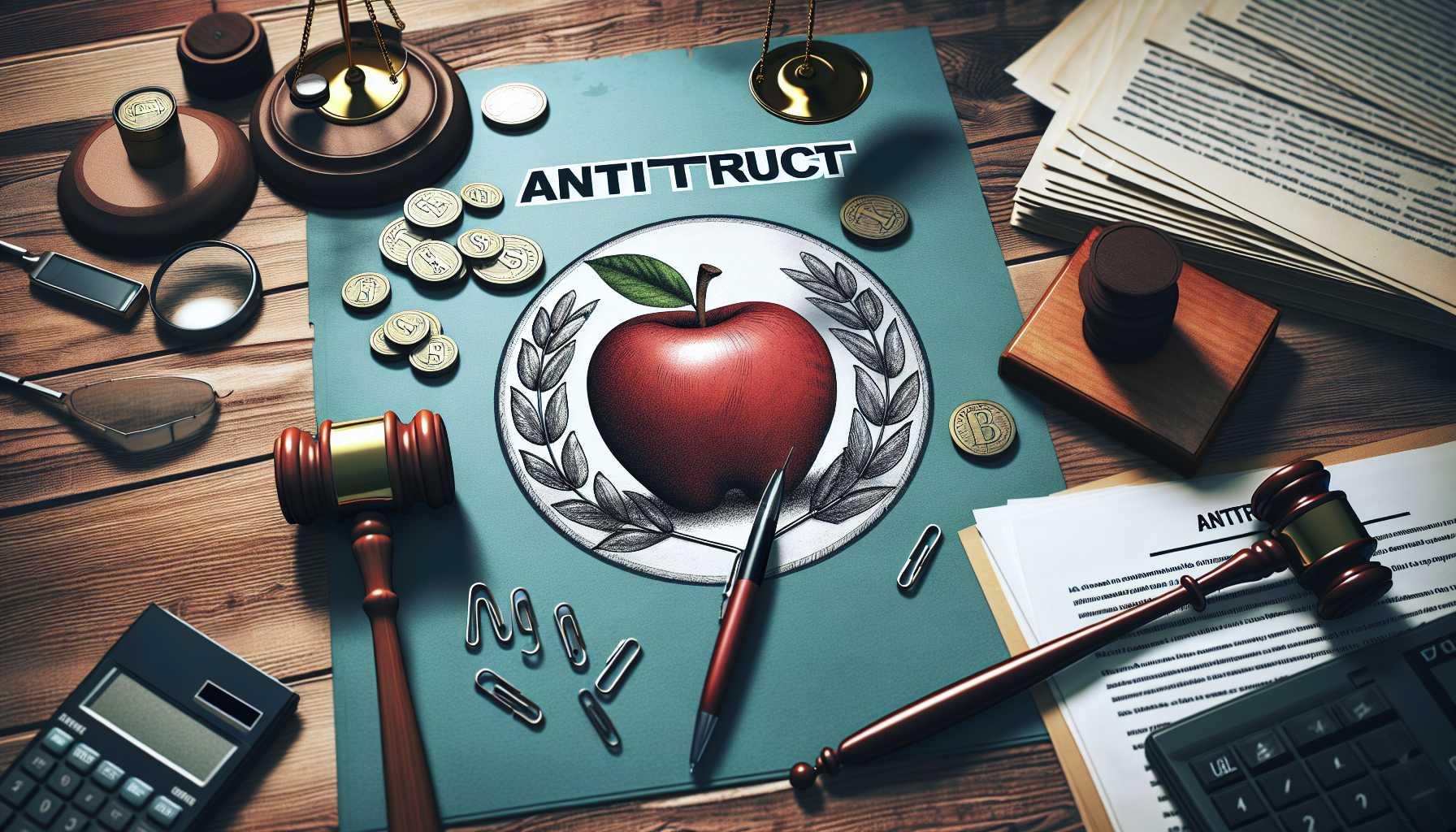Apple’s Ecosystem Under Antitrust Microscope
 Imagine this: one company, a behemoth of tech innovation, lights the path to sleek, user-friendly devices. Its logo, an apple with a bite taken out, is recognized worldwide, synonymous with exclusivity and prestige. But here’s where the plot thickens—what if this shiny apple has a core of controversy? The U.S. Department of Justice (DOJ) is fine-combing through Apple’s garden. Yes, the The New York Times reports that antitrust litigation could be knocking on Apple’s door, putting a spotlight on the company’s ‘walled garden’ strategy. Their ecosystem ostensibly nurtures customer loyalty but casts a shadow of restraint on competitors and consumers hoping to cross the garden’s walls. [iMessage gatekeeping and the Apple Watch’s iPhone two-step] stand accused, as do financial handcuffs barring third-party payment systems from the iPhone’s NFC tap-to-pay features—tethering users to Apple Pay. Senior DOJ officials are sharpening their quills, preparing possibly to ink a lawsuit against Apple as early as 2024. This legal saga could hinge on whether those walls truly protect innovation or preserve monopolistic dominance.
Imagine this: one company, a behemoth of tech innovation, lights the path to sleek, user-friendly devices. Its logo, an apple with a bite taken out, is recognized worldwide, synonymous with exclusivity and prestige. But here’s where the plot thickens—what if this shiny apple has a core of controversy? The U.S. Department of Justice (DOJ) is fine-combing through Apple’s garden. Yes, the The New York Times reports that antitrust litigation could be knocking on Apple’s door, putting a spotlight on the company’s ‘walled garden’ strategy. Their ecosystem ostensibly nurtures customer loyalty but casts a shadow of restraint on competitors and consumers hoping to cross the garden’s walls. [iMessage gatekeeping and the Apple Watch’s iPhone two-step] stand accused, as do financial handcuffs barring third-party payment systems from the iPhone’s NFC tap-to-pay features—tethering users to Apple Pay. Senior DOJ officials are sharpening their quills, preparing possibly to ink a lawsuit against Apple as early as 2024. This legal saga could hinge on whether those walls truly protect innovation or preserve monopolistic dominance.
OpenAI’s Leadership Drama: Ai, Ai, CEO!
 The realms of artificial intelligence were shaken, not by an algorithm or a new model, but by human hands rearranging the puzzle pieces of power. OpenAI—the very company that democratizes AI through products like ChatGPT and DALL-E—turned its own boardroom into a chessboard. Sam Altman, initially ousted as CEO, became the pawn turned king in a tumultuous battle involving boardroom pushes, resignations, and surprise comebacks. His strategic alliance with Microsoft manifested OpenAI’s latest board formation, with an ensemble cast featuring Quora’s Adam D’Angelo, Bret Taylor of Salesforce, and even Larry Summers, former U.S. Secretary of the Treasury. The episode unveiled the intense struggle over governance, direction, and the disposition of AI’s future. From an unassuming piece of software to a power player entwined with Microsoft’s vision, OpenAI’s narrative reads like speculative sci-fi—but it’s our reality.
The realms of artificial intelligence were shaken, not by an algorithm or a new model, but by human hands rearranging the puzzle pieces of power. OpenAI—the very company that democratizes AI through products like ChatGPT and DALL-E—turned its own boardroom into a chessboard. Sam Altman, initially ousted as CEO, became the pawn turned king in a tumultuous battle involving boardroom pushes, resignations, and surprise comebacks. His strategic alliance with Microsoft manifested OpenAI’s latest board formation, with an ensemble cast featuring Quora’s Adam D’Angelo, Bret Taylor of Salesforce, and even Larry Summers, former U.S. Secretary of the Treasury. The episode unveiled the intense struggle over governance, direction, and the disposition of AI’s future. From an unassuming piece of software to a power player entwined with Microsoft’s vision, OpenAI’s narrative reads like speculative sci-fi—but it’s our reality.
Copyright Clash: The Scribes’ Stand Against OpenAI
 Journalists Nicholas A. Basbanes and Nicholas Gage have opened a Pandora’s box labeled “intellectual property,” suing OpenAI and Microsoft for what they term as “massive and deliberate theft” of copyrighted works. These written words are the lifeblood of creative minds, yet the duo claims they’ve been siphoned without due reimbursement to fuel AI’s insatiable learning appetite. It’s a classic struggle of David versus tech Goliath, questioning moral and monetary valuation of content in the AI era. As generative AI surges, creators like George R.R. Martin and Jodi Picoult stand alongside these plaintiffs, demanding their fair share in a narrative that’s far more non-fiction than the AI-generated stories at its core.
Journalists Nicholas A. Basbanes and Nicholas Gage have opened a Pandora’s box labeled “intellectual property,” suing OpenAI and Microsoft for what they term as “massive and deliberate theft” of copyrighted works. These written words are the lifeblood of creative minds, yet the duo claims they’ve been siphoned without due reimbursement to fuel AI’s insatiable learning appetite. It’s a classic struggle of David versus tech Goliath, questioning moral and monetary valuation of content in the AI era. As generative AI surges, creators like George R.R. Martin and Jodi Picoult stand alongside these plaintiffs, demanding their fair share in a narrative that’s far more non-fiction than the AI-generated stories at its core.
Hackers’ Playground: High Profile X Accounts under Siege
 In the age of verification badges and tick marks that promise legitimacy, hackers have found a lucrative loophole. They’re targeting X (the platform formerly known as Twitter) accounts adorned with the authority of gold and grey checks. These digital Trojan horses disguised as legitimate entities peddle crypto scams, with the aim to drain wallets faster than any fictional heist could depict. Governments, businesses, and celebrities alike—no verified account is immune. Each breach not only empties pockets but also erodes trust in a system designed to provide it. It’s a stark reminder that in the cyber jungle, the lion’s mane of a verified account does not always denote a king.
In the age of verification badges and tick marks that promise legitimacy, hackers have found a lucrative loophole. They’re targeting X (the platform formerly known as Twitter) accounts adorned with the authority of gold and grey checks. These digital Trojan horses disguised as legitimate entities peddle crypto scams, with the aim to drain wallets faster than any fictional heist could depict. Governments, businesses, and celebrities alike—no verified account is immune. Each breach not only empties pockets but also erodes trust in a system designed to provide it. It’s a stark reminder that in the cyber jungle, the lion’s mane of a verified account does not always denote a king.
AI Romance for Sale: The Curious Case of Amouranth’s Chatbot
 Flirting with the future, streamer Amouranth’s AI bot tantalizes the internet, promising companionship with a price tag. In a day where virtual relationships are normalized, her AI avatar raked in tens of thousands of dollars, peddling personalized interactions from texts to roleplay. This bot, more than a chatbot, hints at a potential paradigm shift in online interaction, intimacy, and influencer reach. Such developments not only question the lines between reality and AI-generated rapport but also highlight the staggering monetization potential in this newfound digital companionship.
Flirting with the future, streamer Amouranth’s AI bot tantalizes the internet, promising companionship with a price tag. In a day where virtual relationships are normalized, her AI avatar raked in tens of thousands of dollars, peddling personalized interactions from texts to roleplay. This bot, more than a chatbot, hints at a potential paradigm shift in online interaction, intimacy, and influencer reach. Such developments not only question the lines between reality and AI-generated rapport but also highlight the staggering monetization potential in this newfound digital companionship.
The Rise of AI and Its Titans: Nvidia’s Lucrative Leap
 On Wall Street, AI’s allure skyrocketed Nvidia’s shares, positioned as the S&P 500’s crown jewel. But it’s more than just a tale of stocks and numbers. Nvidia, the maestro of machine learning processors, propels the AI boom that’s reshaping industries from gaming to cybersecurity. Their GPUs, once champions of gaming realms, now conquer data centers and power AI innovation to drive potential market valuations into the trillions. Nvidia’s synthesis of hardware, software, and now subscription-based AI services amounts to more than impressive fiscal quarters—it’s a benchmark of our AI-driven epoch. In the cacophony of tech advancements, legal spectacles, AI upheavals, and digital relationships, one constant remains: the almighty byte commands our attention. Whether it’s through the integrated hardware of a smartphone or the generative conversations of a charming bot, we are witnesses to a tech epoch bustling with innovation and fraught with contention—a true mosaic of 21st-century human endeavor.
On Wall Street, AI’s allure skyrocketed Nvidia’s shares, positioned as the S&P 500’s crown jewel. But it’s more than just a tale of stocks and numbers. Nvidia, the maestro of machine learning processors, propels the AI boom that’s reshaping industries from gaming to cybersecurity. Their GPUs, once champions of gaming realms, now conquer data centers and power AI innovation to drive potential market valuations into the trillions. Nvidia’s synthesis of hardware, software, and now subscription-based AI services amounts to more than impressive fiscal quarters—it’s a benchmark of our AI-driven epoch. In the cacophony of tech advancements, legal spectacles, AI upheavals, and digital relationships, one constant remains: the almighty byte commands our attention. Whether it’s through the integrated hardware of a smartphone or the generative conversations of a charming bot, we are witnesses to a tech epoch bustling with innovation and fraught with contention—a true mosaic of 21st-century human endeavor.






